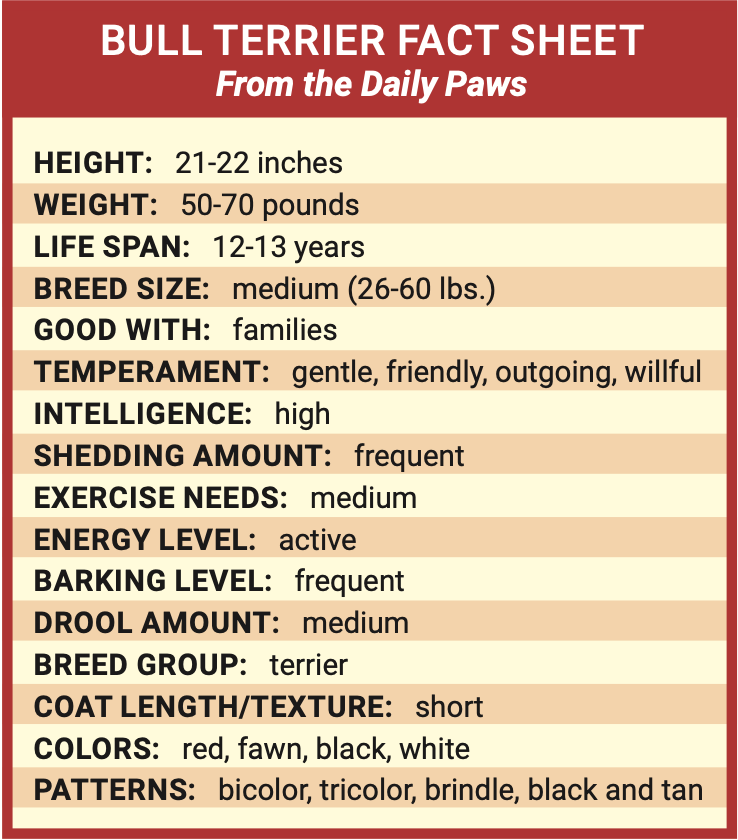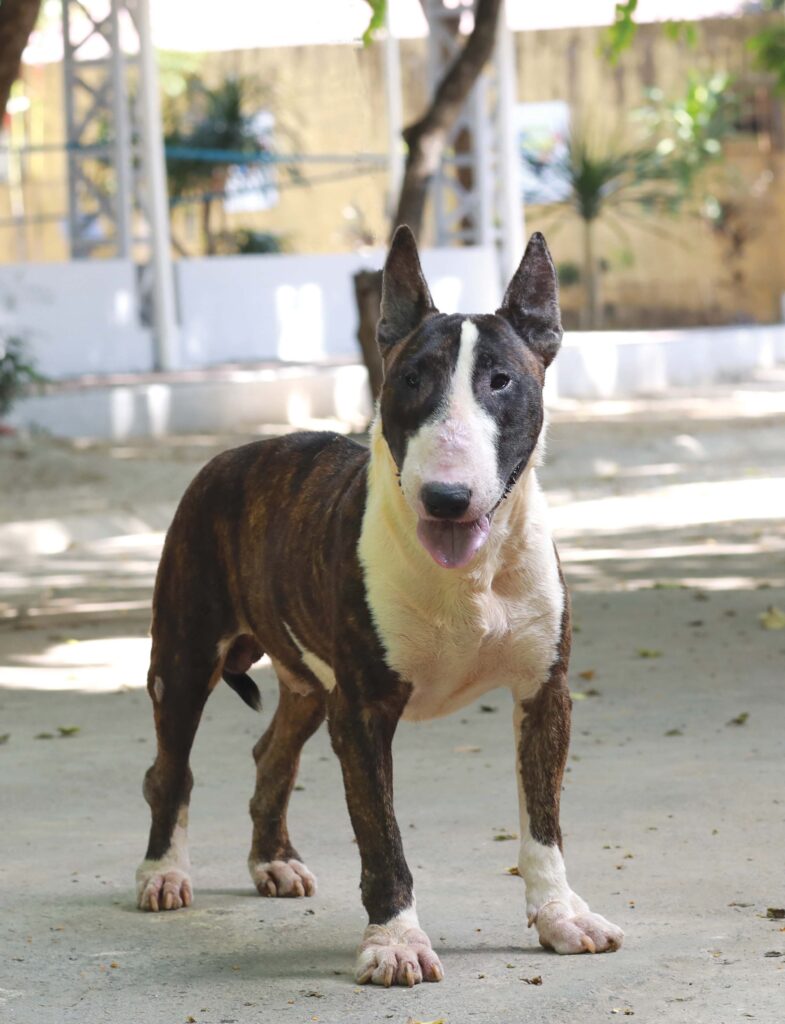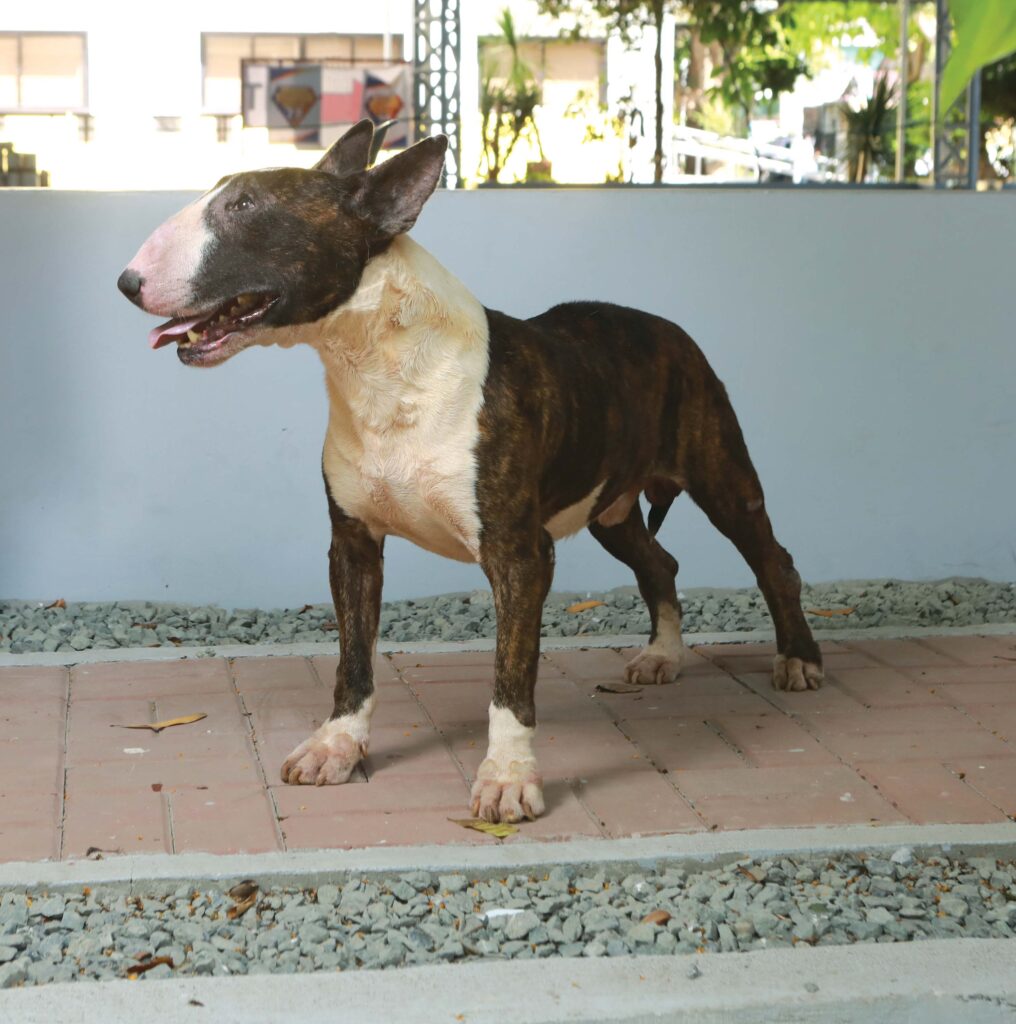
With their muscular build and egg-shaped head, the Bull Terrier is an intimidating Dog, but don’t let appearances fool you. Despite common misconceptions, Bull Terriers are friendly and outgoing companions who enjoy spending time with their humans and receiving lots of pats and scritches.
This canine is more of a lover than a fighter. As a matter of fact, Bull Terriers are well-known for their adoration of all members of the family, especially the younger members.
Due to their outgoing nature and desire to constantly interact with others, they can’t stand being alone for extended periods of time. They wish to participate in whatever their human guardians do.

ANIMALS OF ADVENTURE
These canines have a lot of energy and need regular, active playtime. You may have found your new best friend if you can be firm and consistent with training, keep active to keep up with your Pup, and shower them with lots of love and attention. However, if they don’t receive enough exercise and attention, they can develop destructive tendencies out of boredom.
Having a Bull Terrier in your life is guaranteed to be an adventure. From their early puppyhood to middle age, the Bull Terrier is a very active Dog. They are not the type to like spending hours on end alone; instead, they prefer to hang out with their people whenever possible, participating in whatever activity they are engaged in.
They thrive in a lively household where they can receive enough exercise playing with family members. They also require someone reliable who will be firm (though fair) in enforcing the rules of the household, because if ground rules aren’t set, then Bull Terriers will make up their own. This makes them a less-than-ideal choice for those who are afraid of or unfamiliar with dogs.
MUSCLE MUTTS
Bull terriers are very strong Dogs. They are stocky and muscular, and they come in two sizes: standard and miniature.
The standard version stands about 22 inches tall and weighs about 60 pounds (27 kilograms). The miniature version stands up to 14 inches tall and weighs up to 33 pounds (15 kilograms).
The Bull Terrier’s head, which is egg-shaped and flat on top, is its most distinguishing physical feature. The eyes are small, dark, and set close together. The ears are angular. The body is broad, and the back is short and powerful. The tail of a Bull Terrier is medium in length.

BRED FOR BATTLE
The Bull Terrier was developed in the 19th Century in England by incorporating the now-extinct White English Terrier and the Dalmatian. Although the Bull Terrier was originally bred for pit fighting, breeders began to focus on characteristics that transformed the Dog into a gentleman’s fashionable companion in the late 1800s, according to Encyclopedia Britannica. As a result, they are generally sweet and good-natured today, though they can still be aggressive around other Dogs.
Bull Terriers are known for being energetic, huggable, and exuberant, but they can also be comical, mischievous, and stubborn.
They are ideal for people who like to be active. The Bull Terrier is a good watchdog but only average at protection. It should be noted that these claims are a traditional and widely accepted generalization about them, and individual Bull Terriers may of course behave differently.
BEHAVING BULLS
The Bull Terrier requires no more than a weekly brushing with a rubber mitt or curry brush, making them a low-maintenance breed to care for. The only time this isn’t the case is during their twice-yearly shedding season, when daily brushing is required.
Bull Terriers don’t need frequent baths and can be cleaned with dry shampoo or a moist cloth if they get dirty.
While they are low maintenance in terms of grooming, they can be difficult to train and supervise. Bull terriers are active Dogs from the time they are Puppies until they reach middle age.
Bull Terriers, like most Terriers, can be aggressive toward other animals, particularly other Dogs (especially unneutered males). They require early socialization to be well-behaved around other Dogs: positive, supervised exposure to other Dogs that begins in early puppyhood and continues throughout life.
Bull Terriers are not recommended for homes with young children due to their rambunctious nature, but they make excellent playmates for older children. They require vigorous daily exercise and can be extremely destructive if bored. Patience, confident leadership, and consistency are required for successful Bull Terrier training.

BANNED BULLIES
Unfortunately, because of their fearsome reputation, bull terriers are banned in certain places, such as in the UK and in certain Canadian towns and cities. Pit Bull Terriers are also prohibited or restricted under laws in New Zealand, Belgium, France, Denmark, Poland, Finland, and Norway, according to a 2021 article by Olivia Waring for Metro.co.uk.
In the United States, Pit Bull Terriers are not illegal. It was also illegal to own, sell, or import the breed in Puerto Rico for two decades, but in 2018 the ban was lifted.
HEALTH ISSUES FOR BULL TERRIERS
Although Bull Terriers are a generally healthy breed, they do sometimes suffer from specific health issues. Hereditary nephritis is a form of kidney disease found in these canines, usually at an early age. This is caused by underdeveloped kidneys or malfunctioning kidney filters, which results in high levels of protein in their urine. They can also suffer from renal dysplasia, which hinders the development of their kidneys.
Bull Terriers can also develop spinning, which is a type of obsessive behavior involving tail-chasing. This occurs at about six months of age, continuing for hours, with the Pit Bull showing no interest in food or water. This is sometimes a form of seizure that can be treated with medication, while milder forms of spinning can be addressed simply by eliminating your Dog’s boredom, according to a 2020 article written by Katie Mills Giorgio and Claudia Guthrie for Daily Paws.

DID YOU KNOW?
Bull Terriers, especially white Dogs, are known to be vulnerable to deafness.
The condition affects 18-20% of all Bullies, regardless of color. White Dogs tend to lose hearing in both ears while colored dogs lose hearing in one ear. A bully puppy’s level of deafness in each ear can be measured by a series of tests administered by a veterinarian.
PHOTOS BY JEFFREY LIM






